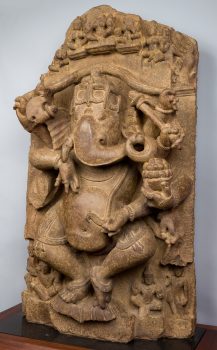Madhya Pradesh, India
11th century


Madhya Pradesh, India
11th century


People visiting a Hindu temple first encounter a sculpture of Ganesha. At the start of a new endeavor, they leave offerings for the elephant-headed god and ask him to remove any obstacles. In this sculpture Ganesha’s flattened belly and darkened trunk resulted from centuries of worshippers rubbing his belly and touching his trunk to receive his blessings.The son of the Hindu gods Parvati and Shiva, Ganesha dances to the rhythm of drums played by two small figures on his right. He wears a crown and carries a cobra as a trophy in his upper pair of arms, while another snake adorns his chest. With one of his left hands he holds a bowl filled with laddoo sweets, and he picks one with his trunk, eating as he dances. His other hands carry a battle-axe and hooked goad, known as an ankusa, used by elephant drivers. Ganesha uses these implements in his role as a remover of obstacles. One of Ganesha’s tusks is usually missing, and he sometimes holds it or a tusk-like radish. In this sculpture one of the now-lost right hands may have once carried it.
A virtuous feeling and deep respect toward an authentic teaching, teacher, or path. Buddhists believe that expansive study, analysis, and meditation are essential steps for cultivating a healthy and enduring devotion.
While the primary religious goal for followers of Buddhism is enlightenment, many of the practices also serve secular goals related to daily life, including ethical conduct and cultivating well-being.
Hindu gods (deva) are thought to be manifestations of the absolute, or Brahman. The goddesses (devi) are considered manifestations of the Great Mother Goddess (Mahadevi), who is seen as the counterpart to Brahman.
As the cradle of Buddhism, northeastern India was and remains today a region abundant in sacred Buddhist sites. Through the late 13th century, India was the epicenter for the production of Buddhist material and visual culture, with teachers, monks, traders, and pilgrims bringing objects back home to Tibet, western Himalayan regions, Nepal, and beyond.
Get the latest news and stories from the Rubin, plus occasional information on how to support our work.